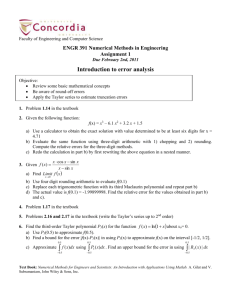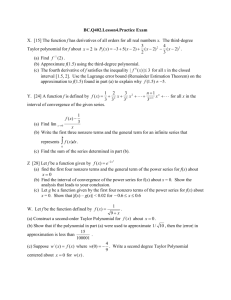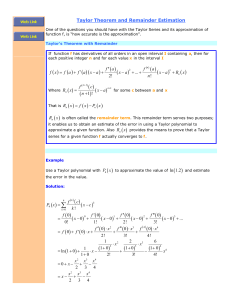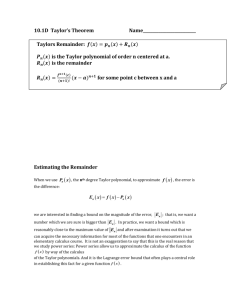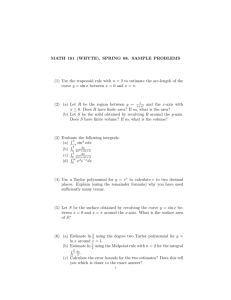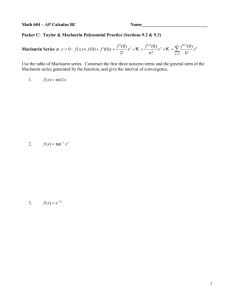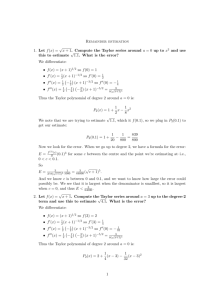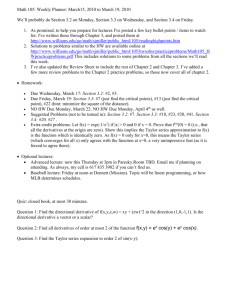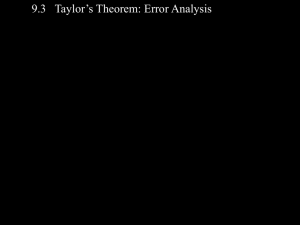Taylor & Maclaurin Series: Error Estimation & Approximation
advertisement
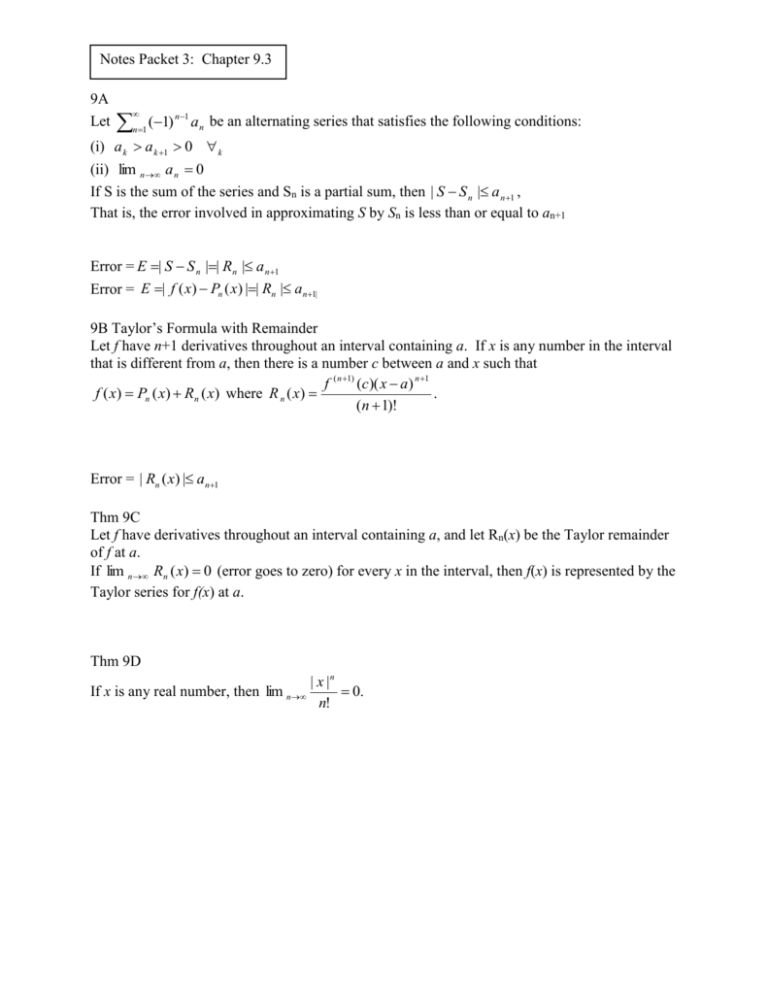
Notes Packet 3: Chapter 9.3 9A Let n 1 (1) n 1 a n be an alternating series that satisfies the following conditions: (i) a k a k 1 0 k (ii) lim n a n 0 If S is the sum of the series and Sn is a partial sum, then | S S n | a n 1 , That is, the error involved in approximating S by Sn is less than or equal to an+1 Error = E | S S n || Rn | a n 1 Error = E | f ( x) Pn ( x) || Rn | an1| 9B Taylor’s Formula with Remainder Let f have n+1 derivatives throughout an interval containing a. If x is any number in the interval that is different from a, then there is a number c between a and x such that f ( n 1) (c)( x a) n 1 f ( x) Pn ( x) Rn ( x) where R n ( x) . (n 1)! Error = | Rn ( x) | an1 Thm 9C Let f have derivatives throughout an interval containing a, and let Rn(x) be the Taylor remainder of f at a. If lim n Rn ( x) 0 (error goes to zero) for every x in the interval, then f(x) is represented by the Taylor series for f(x) at a. Thm 9D If x is any real number, then lim n | x |n 0. n! A function f(x) can be approximated using a polynomial Pn(x) (order n). The absolute value of the remainder of the series |Rn(x)| is the error. So f(x) = Pn(x)+Rn(x) or |Rn(x)| = |f(x) – Pn(x)|. 1. Use the first two nonzero terms of the Maclaurin series to approximate sin(.1). Estimate the error. Use the first two nonzero terms of the Mac series to approximate sin(x). Estimate the maximum error if |x|<1. 1 2. Approximate sin( x 2 )dx to four decimal places. Estimate the error. 0 3. If cos x is replaced by 1 x2 and | x | 0.5 , what estimate can be made of the error? 2 4. The approximation 1 x 1 | x | 0.01 x is used when x is small. Estimate the maximum error when 2 5. Use a Taylor polynomial of order 3 to find the cubic approximation of f ( x) 1 /(1 x) at x 0 . Give the upper bound for the magnitude of the error for | x | 0.1 . 6. the Taylor polynomial T ( x) x x3 is used to approximate f ( x) sin x at x = -0.5. Which 3! is true? A. B. C. D. E. |E|<.0001 .0001<|E|<.0003 .0003<|E|<.005 .005<|E|<.007 .07<|E| 7. Let f be a function whose seventh derivative is f 7 ( x) 10,000 cos x. If x = 1 is in the interval of convergence of the power series for this function, then the Taylor polynomial of degree six, centered at x=0 will approximate f(1) with an error of not more than A. B. C. D. E. 2.45 10 5 1.98 10 4 3.2110 2 0.248 1.984 8. Let f(x) be a function whose Taylor series converges for all x. If | f ( n ) ( x) | 1 when f n (x) is the nth derivative of f(x). What is the minimum number of terms of the Taylor Series centered at x=1 necessary to approximate f(1.2) with an error less than .00001? A. B. C. D. E. 3 4 5 6 10 1 . x 1 (a) Write the first four terms and the general term of the Taylor series expansion of f(x) about x 2 . (b) Use the result from part (a) to find the first four terms and the general term of the series expansion about x 2 for ln | x 1 | . 3 (c) Use the series in part (b) to compute a number that differs from ln by less than 2 0.05. Justify your answer. 9. Let f be the function defined by f ( x) 10. The Taylor series about x 5 for a certain function f converges to f(x) for all x in the (1) n n! (n) interval of convergence. The nth derivative of f at x = 5 is given by f (5) n , and 2 (n 2) 1 f (5) . 2 (a) Write the third-degree Taylor polynomial for f about x = 5. (b) Find the radius of convergence of the Taylor series for f about x = 5. (c) Show that the sixth-degree Taylor polynomial for f about x = 5 approximates f(6) with 1 . error less than 1000
